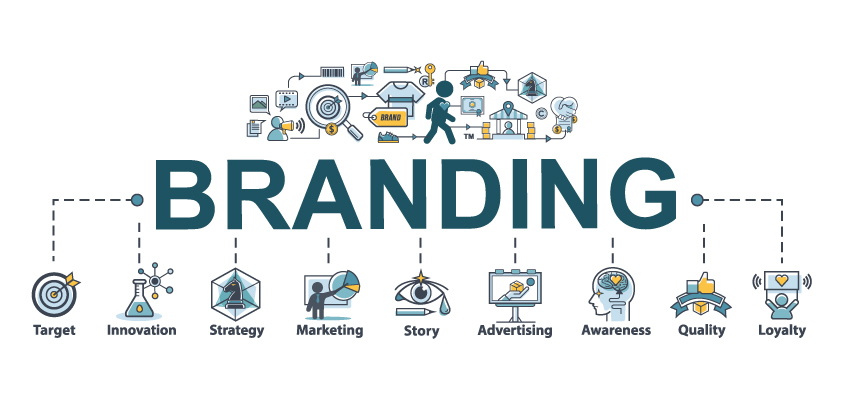The Effect of Robust Branding on Consumer Count On and Loyalty
Wiki Article
Building Durable Branding for Long-Term Organization Success
A natural brand identification not only differentiates a business from its rivals yet also grows count on and loyalty amongst consumers. What methods can organizations use to not just develop a remarkable brand but likewise endure its importance over time?Understanding Brand Identity
Brand name identity works as the foundation of a business's picture and reputation, incorporating aspects such as logo layout, shade messaging, palette, and typography. Each component plays a crucial function in creating a recognizable and cohesive brand name that resonates with its target market. A properly designed logo works as an aesthetic representation of the brand name's values and objective, while a thoroughly picked color combination stimulates certain emotions and organizations.Typography also adds dramatically to brand name identity; the option of font can affect understandings of reliability, expertise, or imagination. Uniformity in these elements cultivates familiarity, allowing clients to quickly recognize and link with the brand name in various contexts.
Additionally, messaging is equally essential, as it connects the brand's core worths and differentiators. Compelling and clear messaging helps establish a strong story that engages consumers and constructs depend on.
Eventually, a well-defined brand name identity not just boosts exposure but also fosters commitment among customers. By investing time and sources into establishing a robust brand identity, organizations can develop a long lasting impact that supports long-term growth and success.
Value of Consistency
Maintaining consistency across all brand aspects is vital for strengthening acknowledgment and depend on among customers. A cohesive brand name identification-- including logo, color palette, messaging, and typography-- creates a unified experience that consumers can conveniently determine. When these components are regularly used throughout numerous platforms, from advertising products to social media, they enhance the brand name's existence and make it a lot more remarkable.Inconsistent branding can lead to complication and dilute brand name equity. It elevates questions regarding reliability and credibility when consumers experience variations in brand presentation (Robust Branding). This disparity can wear down trust fund, making it less likely that customers will select your brand over rivals
Additionally, regular branding cultivates consumer commitment. When customers know what to get out of a brand, they are more probable to form an emotional connection, leading to repeat purchases and long-lasting relationships.
To achieve consistency, companies must develop extensive brand guidelines that lay out the correct usage of all brand elements. Normal training for staff members and periodic audits of advertising and marketing materials can help make certain adherence to these standards, eventually paving the way for sustained service success through a solid and dependable brand picture.

Crafting a Customer-Centric Experience
Developing a customer-centric experience is important for businesses intending to promote strong partnerships with their clientele. This technique prioritizes understanding and meeting the demands, choices, and expectations of customers at every touchpoint. By proactively paying official statement attention to consumer responses and conducting comprehensive market research, companies can tailor their offerings and solutions to line up a lot more carefully with what their target market wishes.Central to crafting a customer-centric experience is the personalization of communications. Robust Branding. Using information analytics permits business to segment their customer base and provide customized advertising messages, items, and services. This not just enhances consumer complete satisfaction however additionally drives loyalty and motivates repeat company
In addition, efficient interaction plays a crucial function in a customer-centric approach. get redirected here Transparent and open dialogue grows trust fund and reinforces the bond in between business and its consumers. Companies must ensure that their client service groups are trained, understanding, and receptive, giving support that mirrors an understanding of individual client trips.
Leveraging Digital Platforms
In today's digital age, organizations need to use the huge possibility of online systems to improve their branding initiatives and connect with customers. These platforms, that include social media sites, web sites, and shopping networks, provide special possibilities for brands to involve with their target market in real-time, fostering a feeling of community and commitment.Social media site platforms such as Facebook, Instagram, and Twitter enable brand names to share their stories, worths, and products while permitting for direct communication with consumers. This two-way interaction not only humanizes the brand name yet also aids businesses collect valuable understandings into consumer choices and concerns. In addition, a solid online visibility can improve brand visibility and bring in brand-new customers via organic reach and targeted advertising.
Additionally, having a properly designed web site offers as a main center for brand details, showcasing product or services while using a smooth individual experience. Ecommerce abilities even more assist in straight sales, making certain a practical shopping experience for customers. By successfully leveraging these digital platforms, businesses can build a durable brand identity that resonates with their target market, inevitably adding to long-lasting success and growth.
Gauging Brand Name Success
Determining brand success is necessary for services aiming to review the performance of their branding methods and campaigns. This assessment allows organizations to comprehend exactly how well their brand reverberates with target market and drives company goals. Trick efficiency signs (KPIs) such as brand name recognition, client involvement, and loyalty are important metrics to consider.Brand name awareness can be gauged through studies, social media reach, and internet site traffic analytics. High degrees of understanding suggest that consumers identify and recall the brand name, which is foundational for future investing in decisions. Client involvement metrics, such as social networks communications and email open rates, give understanding into exactly how proactively customers are participating with look here the brand name.
Furthermore, loyalty can be evaluated through metrics like Web Promoter Score (NPS) and repeat purchase prices. These signs disclose not only consumer satisfaction yet also the probability of customers advising the brand to others.
Verdict
A cohesive brand name identification, identified by a memorable logo design, consistent color palette, and thoughtful typography, fosters customer acknowledgment and trust fund. Determining brand name success with crucial performance indicators aligns methods with market demands, eventually driving continual development and durability in a competitive landscape.A natural brand identification not just differentiates a business from its rivals but likewise cultivates trust fund and loyalty amongst customers - Robust Branding. What approaches can companies use to not just produce a remarkable brand yet also sustain its significance over time?
By effectively leveraging these digital platforms, businesses can construct a robust brand identification that reverberates with their target audience, ultimately contributing to long-lasting success and development.

Report this wiki page